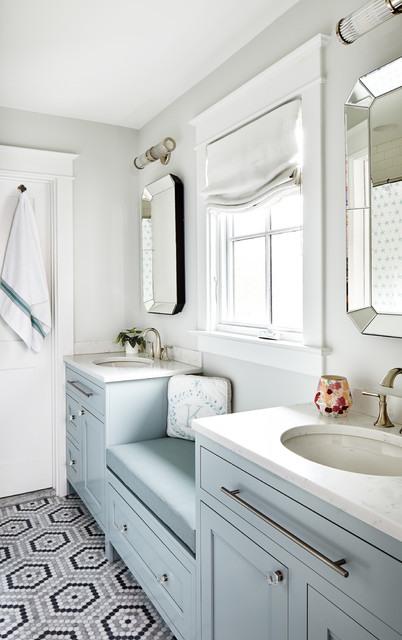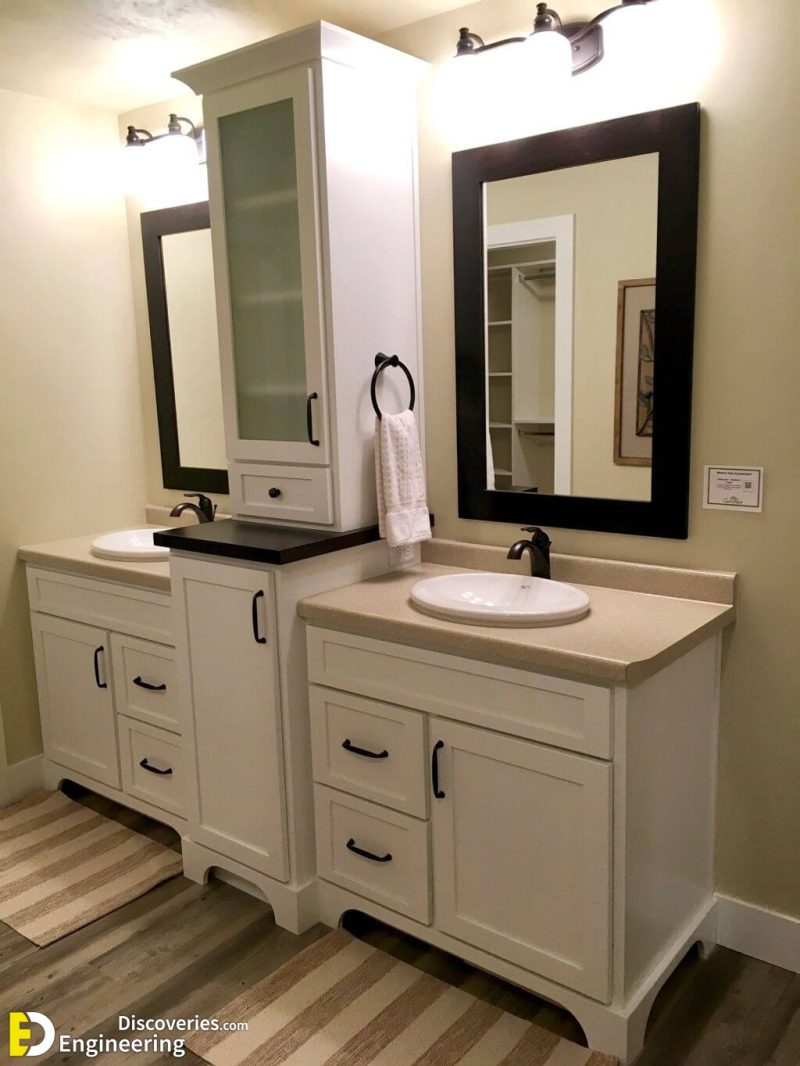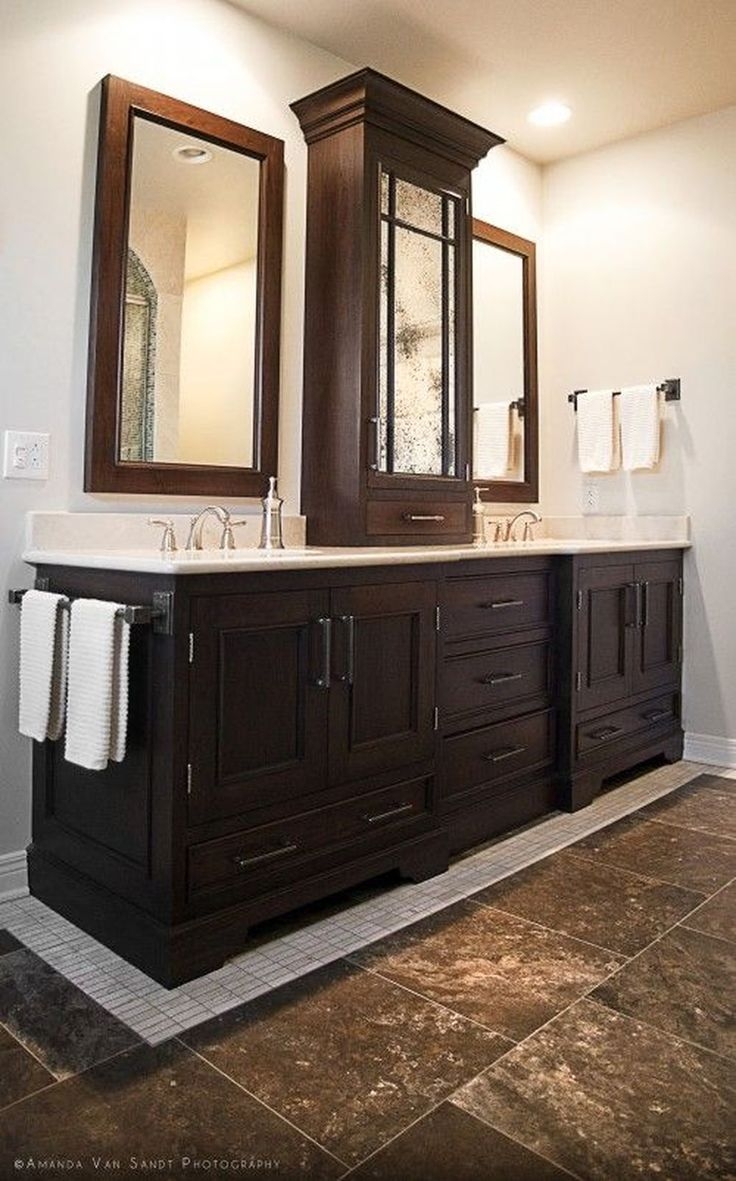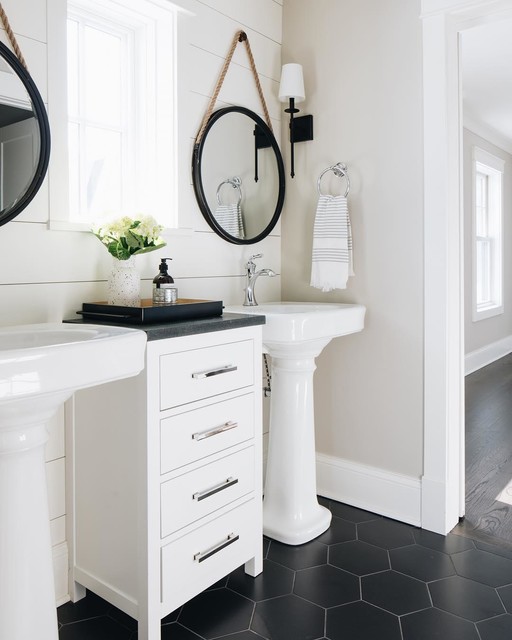The Benefits of Installing a Bathroom Cabinet Between Sinks
A well-designed bathroom is not only functional but also aesthetically pleasing. One often overlooked element in bathroom design is the space between sinks. Installing a bathroom cabinet between sinks can provide numerous benefits, from maximizing storage to enhancing the overall style of the space. Here are the advantages of incorporating a bathroom cabinet between sinks.
- Increased Storage Capacity: One of the primary benefits of installing a bathroom cabinet between sinks is the additional storage it provides. With a dedicated cabinet in this space, you can keep all your bathroom essentials neatly organized and easily accessible. From toiletries to cleaning supplies, having a cabinet between sinks ensures that everything has its designated place, reducing clutter and creating a more organized environment.
- Enhanced Organization: A bathroom cabinet between sinks can be a game-changer when it comes to maintaining a clutter-free space. With multiple shelves and compartments, you can categorize your items and create a systematic storage system. Arrange your towels, toiletries, and other daily essentials in a way that makes them easily visible and accessible. This not only saves time but also promotes a sense of calm and order in your bathroom.
- Seamless Style Integration: Choosing the right bathroom cabinet can elevate the overall style of your sink area. Whether your bathroom has a modern, minimalistic design or a more traditional aesthetic, there are cabinets available in a wide range of styles, materials, and finishes to complement your existing décor. A well-chosen cabinet can seamlessly integrate with your sinks, creating a cohesive and visually appealing look.
- Customizable Options: Bathroom cabinets between sinks come in various sizes and configurations, allowing you to customize them to fit your specific needs. Consider the dimensions of your sink area and the items you wish to store when selecting a cabinet. From single-door cabinets with ample storage to multi-tiered options with pull-out drawers, you can find the perfect cabinet that maximizes your space and caters to your storage requirements.
- Ideal for Small Bathrooms: For those with limited bathroom space, installing a cabinet between sinks is a smart space-saving solution. By utilizing the often-underutilized area between sinks, you can make the most of every inch in your bathroom. Opt for a compact cabinet design that doesn’t compromise on storage capacity, allowing you to keep your essentials close at hand without overcrowding the space.

How a Bathroom Cabinet Between Sinks Can Keep Your Space Clutter-Free
A cluttered bathroom can be a source of stress and frustration. However, with the addition of a bathroom cabinet between sinks, you can achieve organizational bliss. Let’s see how a cabinet between sinks can help you keep your space clutter-free and create a more serene and functional bathroom environment.
Categorize and Declutter: The presence of a bathroom cabinet between sinks provides an opportunity to categorize and declutter your bathroom essentials. Create sections within the cabinet for different items such as toiletries, cleaning supplies, and towels. Use baskets or dividers to further organize smaller items like cosmetics or hair accessories. By keeping everything in its designated place, you can easily locate items and maintain a clutter-free countertop.
Utilize Vertical Space: A bathroom cabinet between sinks allows you to make use of vertical space, which is often underutilized in bathrooms. Opt for a cabinet with multiple shelves or adjustable heights to accommodate items of varying sizes. Utilize the vertical space to store towels, extra toilet paper, or even decorative items. By maximizing the height of the cabinet, you can free up valuable counter space and maintain a tidy and organized bathroom.
Conceal Unsightly Items: Not all bathroom essentials are visually appealing, and having them on display can disrupt the overall aesthetic of the space. A bathroom cabinet between sinks provides a discreet storage solution for items such as cleaning products, spare toiletries, or personal hygiene items. By keeping these items hidden behind closed doors, you can maintain a clean and streamlined look in your bathroom.
Easy Maintenance and Cleaning: Without a dedicated storage area, cleaning your bathroom can become a tedious task. With a cabinet between sinks, you can easily access and clean the countertop and sink area without having to move or rearrange multiple items. Simply close the cabinet doors and wipe down the surface, ensuring a quick and hassle-free cleaning routine. This not only saves time but also promotes a cleaner and more hygienic bathroom environment.
Personalized Organization: Every individual has different organizational preferences and needs. A bathroom cabinet between sinks allows you to personalize your storage solutions according to your specific requirements. Customize the shelves, drawers, or compartments to accommodate your preferred organization system. Whether you prefer to sort items by category, color, or frequency of use, a cabinet provides the flexibility to create a system that works best for you.
Choosing the Perfect Bathroom Cabinet to Complement Your Sink Area
When it comes to bathroom design, style, and functionality go hand in hand. Installing a bathroom cabinet between sinks not only enhances the functionality of the space but also adds a touch of style. Let’s find out the importance of choosing the perfect bathroom cabinet to complement your sink area, ensuring a harmonious and visually appealing bathroom.
Consider the Overall Design: Before selecting a bathroom cabinet, consider the overall design and aesthetic of your bathroom. Is it modern, traditional, or somewhere in between? Choose a cabinet that complements the existing style and seamlessly integrates into the overall design scheme. For a modern bathroom, opt for sleek and minimalistic cabinet designs with clean lines, while a traditional bathroom may benefit from cabinets with decorative details and ornate handles.
Coordinate with Sink Materials: To create a cohesive look, consider coordinating the materials of your sink and cabinet. If you have a porcelain sink, a cabinet with a similar finish or complementary color can create a unified and visually pleasing effect. Alternatively, if you have a stone or concrete sink, a cabinet with a natural wood finish can add warmth and texture to the space. Paying attention to these details can elevate the overall style and sophistication of your bathroom.
Focus on Storage Solutions: While style is important, don’t forget about the functionality of the cabinet. Evaluate your storage needs and choose a cabinet that provides adequate space to store your bathroom essentials. Consider the number of shelves, drawers, or compartments required to accommodate your items. Additionally, look for cabinets with smart storage solutions such as adjustable shelves, built-in organizers, or pull-out trays to maximize the usability of the space.
Size and Proportions: Proper sizing and proportion are crucial when selecting a bathroom cabinet between sinks. Measure the available space between your sinks and choose a cabinet that fits comfortably without overpowering the area. A cabinet that is too small may not provide sufficient storage, while one that is too large can make the space feel cramped. Take into account the dimensions of your sinks and the surrounding area to ensure a balanced and visually pleasing installation.
Personalize with Hardware and Accessories: Don’t underestimate the impact of hardware and accessories in enhancing the style of your bathroom cabinet. Choose handles or knobs that complement the overall design and finish of your cabinet. Consider matching the hardware with other fixtures in your bathroom, such as faucets or towel bars, for a cohesive look. Additionally, accessorize the cabinet with decorative elements such as plants, candles, or artwork to add personality and style to the space.
Utilizing a Bathroom Cabinet Between Sinks in Small Bathrooms
Small bathrooms often present challenges when it comes to storage and organization. However, by utilizing a bathroom cabinet between sinks, you can maximize the available space and create efficient storage solutions. Below are the benefits of installing a cabinet between sinks in small bathrooms and provide tips on how to make the most of this space-saving solution.
Utilize Vertical Storage: In small bathrooms, every inch of space counts. A cabinet between sinks allows you to utilize vertical storage effectively. Choose a cabinet that extends from the countertop to the ceiling, providing ample storage space for towels, toiletries, and other bathroom essentials. Utilize adjustable shelves or stackable storage containers to make the most of the vertical space and accommodate items of varying heights.
Opt for Slim and Compact Designs: To prevent the cabinet from overpowering the limited space in a small bathroom, opt for slim and compact designs. Look for cabinets with a shallow depth that can fit snugly between the sinks without impeding movement. Additionally, consider cabinets with sliding or folding doors instead of swinging doors to save space and ensure easy access to the contents inside.
Choose Reflective Surfaces: Another trick to create an illusion of space in a small bathroom is to choose a cabinet with reflective surfaces. Mirrored or glass-paneled cabinet doors can reflect light and give the impression of a larger and more open space. This not only adds a touch of elegance but also enhances the overall aesthetics of the bathroom.
Utilize Hidden Storage: A bathroom cabinet between sinks provides an opportunity to incorporate hidden storage solutions. Consider cabinets with built-in drawers or pull-out trays that can be discreetly tucked away when not in use. These hidden storage compartments are perfect for storing smaller items like makeup, brushes, or grooming tools, keeping them organized and easily accessible.
Create a Seamless Look: To create a seamless look in a small bathroom, choose a cabinet that matches the color or finish of the existing fixtures and materials. A cabinet that blends in with the surrounding elements creates a cohesive and visually pleasing appearance. Additionally, consider installing matching countertops or backsplashes to further enhance the seamless look and make the space feel more cohesive and spacious.
DIY or Professional Installation?
Installing a bathroom cabinet between sinks can enhance the functionality and aesthetics of your bathroom. However, when it comes to the installation process, you may wonder whether to tackle it as a DIY project or hire a professional. We will guide you through the considerations and steps involved in installing a bathroom cabinet between sinks, helping you make an informed decision on whether to take the DIY route or opt for professional installation.
Assess Your Skills and Experience: Before deciding whether to install the bathroom cabinet yourself or hire a professional, assess your skills and experience with similar projects. If you have prior experience with carpentry, plumbing, or general home improvement, you may feel confident in taking on the installation yourself. However, if you lack the necessary skills or are unsure about the process, it may be best to enlist the help of a professional.
Evaluate the Complexity of the Project: Consider the complexity of the installation project. Installing a bathroom cabinet between sinks can involve tasks such as measuring, leveling, drilling, and connecting plumbing if necessary. If the project involves intricate steps or requires modifications to existing plumbing or electrical work, it may be wise to consult a professional to ensure a safe and accurate installation.
Gather the Necessary Tools and Materials: Whether you decide to install the bathroom cabinet yourself or hire a professional, it’s important to gather the necessary tools and materials for the project. These may include a tape measure, level, drill, screws, anchors, and any additional hardware or plumbing components required. If you choose to hire a professional, they will typically bring their tools and materials.
Follow Manufacturer’s Instructions: If you opt for a DIY installation, carefully read and follow the manufacturer’s instructions that accompany the bathroom cabinet. These instructions often provide step-by-step guidance specific to the cabinet model you have chosen. Pay close attention to any measurements, recommended installation methods, or special considerations mentioned in the instructions.
Consider Safety and Code Compliance: When installing a bathroom cabinet between sinks, safety and code compliance should always be a priority. If you’re unsure about the plumbing or electrical aspects of the installation, it is advisable to consult a professional who can ensure that all connections are secure and meet building codes. This will help prevent potential hazards and ensure the longevity of your installation.
Ideas for the Space Between Double Sinks in the Bathroom
Bathroom Storage Tower – Ideas on Foter
favorite home from parade of homes
Vanities & Linen Cabinets – Wardcraft Homes Wardcraft Homes
Ideas for the Space Between Double Sinks in the Bathroom
Ideas for Home Decor
Space Between Double Sinks in the Bathroom
Vanity Sink Base Cabinets for Your Bathroom KraftMaid
Related Posts:
- Builder Grade Bathroom Cabinets
- Tall Free Standing Bathroom Cabinets
- Small Bathroom Cabinet With Doors
- Victorian Style Bathroom Cabinets
- Trendy Bathroom Cabinets
- Drawer Inserts For Bathroom Cabinets
- Small Floor Standing Bathroom Cabinet
- Big Bathroom Cabinet
- Inset Bathroom Cabinets
- Best Paint For Painting Bathroom Cabinets










